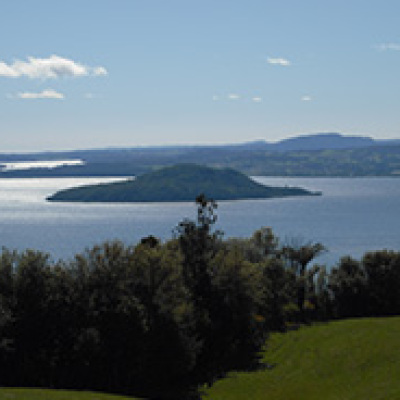
11 November 2015
A report into the effects of alum dosing in the Rotorua Te Arawa lakes has highlighted uncertainty in its long-term application and supports the need for alternative solutions to sustain water quality.
The Ecotoxicological Review of Alum Applications to the Rotorua Lakes report was produced by the University of Waikato and reviews international literature to provide guidance on a number of concerns associated with long-term alum dosing of the Rotorua lakes. This included highlighting that alum dosing should be an interim solution for improving water quality while long-term solutions such as land use changes to reduce nitrogen take effect.
Alum dosing (aluminium sulphate) is a highly effective, common method for removing phosphorous from freshwater systems. Bay of Plenty Regional Council is using it to help meet water quality targets for Lakes Rotorua, Rotoehu and Okaro.
Bay of Plenty Regional Council Chair in Lake Restoration at the University of Waikato, Professor David Hamilton, says the report suggests alternative water quality management tools are required for the Rotorua lakes due to potential for chronic ecological effects, despite its short-term use being considered safe.
“In some parts of the USA and Europe alum has been used for the restoration of fresh water lakes. Under pH-neutral conditions aluminium forms a non-toxic floc. However under acidic or alkaline conditions aluminium can dissolve and may become toxic to aquatic fauna,” he says.
“The quantity of alum that can be safely added to a water body depends on its ability to resist a change in pH. Most of the Rotorua lakes, in particular Lake Rotorua, have limited resistance to the acidifying effects of alum.
“The current application rates used in the Rotorua lakes are very conservative compared with overseas applications, and this minimizes the risk of acute short-term effects. Chronic effects from long-term alum dosing are not as well understood.”
Professor Hamilton says although there is no evidence that alum dosing affects the food chain in Lake Rotorua, a precautionary approach is needed because of the information gap related to long-term exposure of aquatic fauna to alum.
Bay of Plenty Regional Council General Manager for Environmental Delivery Warwick Murray says while alum dosing has proved to be a valuable tool for cleaning up the lakes it is not favoured by all groups in the community and was never intended as a permanent solution.
“We have seen a huge improvement in Lake Rotorua in particular and although monitoring does not indicate undue risk from the current alum programme there is a lack of research into the long-term effects of alum on the environment. We need to be aware of the potential risks of long term use and be conscious of the fact that not everyone is happy with its use.”
“The report supports the advice that alum dosing should not be used as a permanent solution, but that it has a place as a water quality management tool until nutrients entering the lake are reduced to sustainable levels through land use change and the ongoing improvements in nutrient management practices.”
A Science Evening will be held next Tuesday where Dr Grant Tempero, author of the report, will talk about his findings. Hannah Mueller from University of Waikato and Professor Hamilton will also present research findings for the Rotorua Te Arawa Lakes Programme. Mueller will be discussing an ecosystem services approach to assessing the value of Lake Rotorua to the region.
“We invite members of the public to come and hear from the experts themselves about this research and the part it plays to help protect and restore water quality in our lakes”, Mr Murray said.
The Science Evening will be held on Tuesday 17 November, from 6 – 8pm at the Energy Events Centre, Queens Drive, Rotorua.
RSVP online on the Rotorua Lakes website rotorualakes.co.nz or call Hariata Ngatai 0800 884 881 ext 7445. You can also find a copy of the report at www.rotorualakes.co.nz/lakerotorua_science or request a copy at info@rotorualakes.co.nz
The Rotorua Te Arawa Lakes Programme is a partnership between Bay of Plenty Regional Council, Rotorua Lakes Council and Te Arawa Lakes Trust with funding from Ministry for the Environment.
The partner organisations work together to protect and restore water quality in 12 Rotorua lakes for the enjoyment and use of present and future generations while recognising and providing for the traditional relationship of Te Arawa with their ancestral lakes.
The Rotorua Te Arawa Lakes Programme was established in 2013 in response to water quality targets set under the Resource Management Act, National Policy Statement for Freshwater Management and the Bay of Plenty Regional Council’s Regional Land and Water Plan, which is part of the Regional Policy Statement.
Bay of Plenty Regional Council’s vision is “Thriving together - mō te taiao, mō ngā tāngata”. The vision is supported by Council’s Community Outcomes.
Water quality and quantity: Our water and land management practices maintain and improve the quality and quantity of the region’s water resources.
Environmental protection: We maintain and enhance regional biodiversity and our air, land, freshwater, geothermal and coastal resources for the benefit of our communities. We support others to do the same.
Resilience and safety: Our planning and infrastructure provides resilience to natural hazards and flooding so that our communities’ safety is improved and maintained.
Regional collaboration and leadership: We have established the region’s priorities and strategic direction with our partners and communities. We have collaborated to achieve integrated planning across the Bay of Plenty.
Economic development: We facilitate and enable initiatives that boost the region’s economic performance